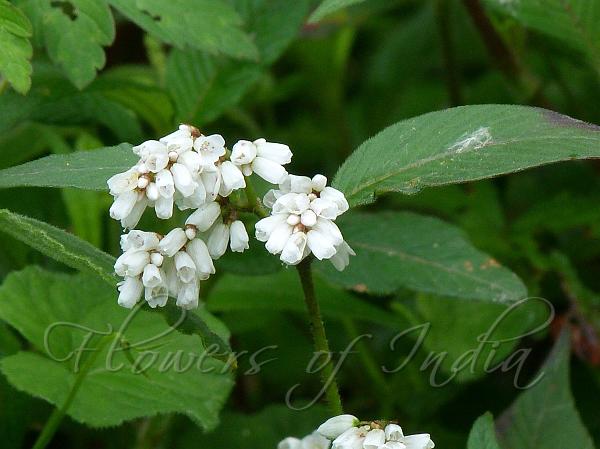|
| Bellflower Knotweed |
|

|

| File size | 538053 |
| Original date | 6/21/13 9:57 AM |
| Resolution | 2048 x 1536 |
| Flash | Flash did not fire, auto |
| Focal length | 108.0mm |
| Exposure time | 1/125s |
| Aperture | 5.2 |
| Focus Distance | |
| Metering Mode | Multi-segment |
| Camera make | Panasonic |
| Camera model | DMC-FZ40 |
| Sensor type | OneChipColorArea |
|
|
|
|
Photo: |
Botanical name: Koenigia campanulata Family: Polygonaceae (Knotweed family)
Synonyms: Persicaria campanulata, Aconogonon campanulatum, Polygonum campanulatum
Synonyms: Persicaria campanulata, Aconogonon campanulatum, Polygonum campanulatum
Bellflower Knotweed is perennial herb with stems
nearly erect, prostrate at base, 2-3 ft tall, branched, channelled,
hairy. Leaf-stalk is 7-10 mm, densely velvety. Leaf blade is narrowly
ovate or broadly so, 8-15 x 3-5 cm, both surfaces hairy, base broadly
wedge-shaped or somewhat rounded, margin densely shortly ciliate, tip
long pointed or falling off. Ocrea tubular, 7-15 mm, membranous,
pilose, apex oblique. Flowers are borne in panicles, bracts ovate,
about 3 mm, membranous, glabrous, each 2- or 3-flowered. Flower-stalk
is 1.5-2 mm. Flowers pinkish or white, 5-parted; tepals obovate, about
3 mm, unequal. Stamens 8, included; anthers purple. Styles 3,
threadlike, about 2 mm; stigmas capitate. Achenes included in
persistent perianth, yellow-brown, slightly shiny, broadly ellipsoid,
trigonous, about 3.5 mm. Bellflower Knotweed is found on slopes,
valleys, at altitudes of 1400-4100 m, in China, Bhutan, N Myanmar,
Nepal, Sikkim, Arunachal Pradesh. Flowering: July-August.
| Identification credit: Nongthombam Ullysess | Photographed in Tawang, Arunachal Pradesh. |
• Is this flower misidentified? If yes,